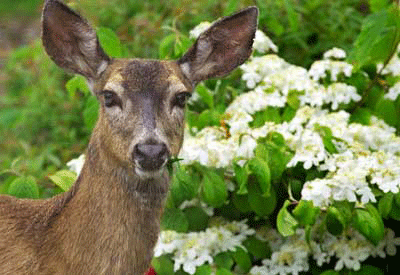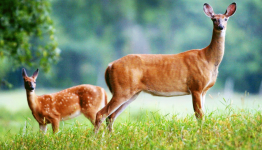The White-tailed deer once teetered at the brink of extinction, especially in places like the Midwest of the United States where hunting was heavy. But since 1970, the White-tailed deer’s population has witnessed a steady growth. It is estimated that they have a population size of 25 million, thanks to extensive efforts put into protecting the animal from hunters. However fortunate we are for a hearty deer population, we must consider effective ways of deterring white-tailed deer.
It comes as no surprise that the White-tailed deer (Odocoileus virginianus) is well spread across the World. Most people see this animal as a pest, eating away planted crops, destroying tree shrubs and being responsible for most of the accidents that happen on the highway. To solve this nagging problem, most people have resorted to hunting, killing both the bucks and the doe. In places like Canada where the animal is found in great numbers, hunters are allowed to hunt them, but only during open seasons.
Where they live
White-tailed deer are mostly found around the edges of forestlands, plantation fields and in some open areas. They prefer taking up homes in conifer and deciduous forests, low grasslands, and even deserts provided there is water supply. Activities like land clearing has led to the reduction in the population size of predators, which  not only prey on white deer, but also on her cousin –the black-tailed deer and mule deer. These species of deer are never afraid of coming into the living quarters on humans, and would feed on vegetable gardens, planted flowers, shrubs and small trees when they do. When thirsty, they sometimes source their water from artificial supplies.
not only prey on white deer, but also on her cousin –the black-tailed deer and mule deer. These species of deer are never afraid of coming into the living quarters on humans, and would feed on vegetable gardens, planted flowers, shrubs and small trees when they do. When thirsty, they sometimes source their water from artificial supplies.
White-tailed deer oftentimes, stay in groups based on their sex, mixing with themselves during the breeding season which starts in November and runs till January. During breeding seasons, bucks would fight for domain rights. A doe produces between one and three fawns, weaning them for a period of a year. As the new fawns mature, they will grow their own set of antlers, measuring several inches and then leave their mother. Doe prefer to live together in herds during summer. When in the wild, white-tailed deer live for as long as 10 years.
White-tailed deer have a super sense of hearing and smell, and they would do anything to avoid human contact. They are nocturnal creatures, preferring to graze and go in search of food at night, staying awake till morning. They prefer sleeping in areas with dense covering, sleeping for a short period of time. When agitated, the animal would stamp its hooves and produce snort sounds with its nose. When it senses danger, the white-tailed deer would raise its tail, revealing the bright flash of white which serves as an alarm to other deer. They can easily sense danger, but they have learned not to fear humans, cars and pets, but would take to flight when approached, running to the nearest cover.
These set of animals graze on shrubs, grass, nuts, berries, acorns, fruits, lichens, and fungi. The buck when fully matured weighs 400 pounds, whereas the doe weighs 200. The deer with the biggest body weight can be easily seen during the peak of winter. One deer requires between 5 to 10 pounds of food, feeding mostly on vegetation within its habitat. When they find their way into yards, they would feed on fruits, ornamental shrubs and trees planted for decorative purposes.
 When they land on urban areas, they would feed on roses, Azaleas, hostas and rhododendrons. A single deer can singlehandedly wreck great damage on a garden. In their numbers, they can eat up 2 acres of landscape plantation. They agile legs to lift them pass fences as high as 9 feet. With time, they will eventually get to see tethered dogs as posing no harm. Being clever set of creatures, they teach whatever they learn to their young ones.
When they land on urban areas, they would feed on roses, Azaleas, hostas and rhododendrons. A single deer can singlehandedly wreck great damage on a garden. In their numbers, they can eat up 2 acres of landscape plantation. They agile legs to lift them pass fences as high as 9 feet. With time, they will eventually get to see tethered dogs as posing no harm. Being clever set of creatures, they teach whatever they learn to their young ones.
This makes particularly difficult to deter deer. Being color blind, the white-tailed deer do not run from bright colored objects. Most people of resorted to the use of foul smelling products, spreading them on shrubs, flowerbeds and trees so as to attack the taste buds of the animal. These deterrents are temporal, as the white-tailed deer would eventually figure out how to circumvent the foul smell.
The most effective way of keeping them away is by threating them with physical harm. Their fear of death will keep them away from your yard for good. They often stay away from areas they sense a potential threat. The best way to scare them off is to use their sense of smell against them. Plant an odor that sends danger signals to them, and they would stay away. This is best done around areas where they like coming to graze. Once they learn to avoid an area, they will teach their fawns to follow suit.
A popular deer and rabbit repellent known as the Nature’s MACE Deer and Rabbit MACE will be your best weapon for driving away trespassing deer as it attacks their sense of smell and safety. Its advanced formula works by making a deer believe that danger is nearby. Deer Mace is made from some organic ingredients which take advantage of the deer’s sense of smell. The moment their nose picks of the smell, the defense mechanism would be activated, making them flee for the fear of a predator. Frequent application of Deer and Rabbit Mace will eventually make them learn to avoid your yard and garden.
Deer and Rabbit Mace is a biodegradable weapon which can be effectively used for scarring off mule deer, as well as black and white-tailed deer. Apply it on your garden and ornamental plants for a period of 60 days and the deer will stay away for good. Deer and Rabbit Mace contains no harmful chemicals, neither does it contain toxins that could hurt the deer or even a human.










